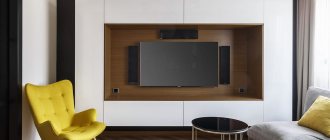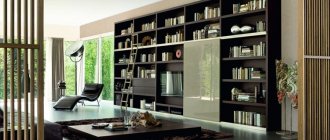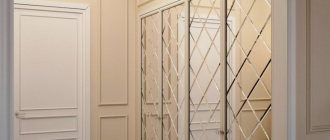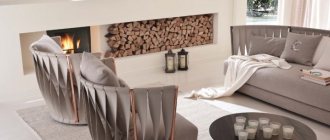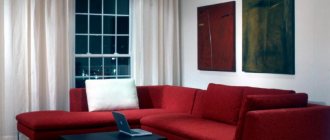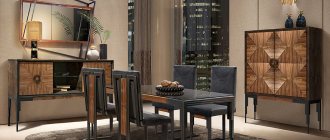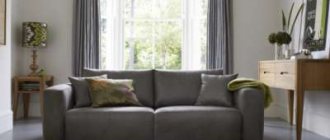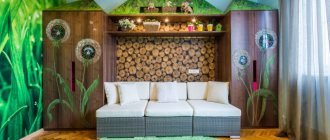It is no secret that the interior must perform several functions: from providing convenience and a pleasant visual component to telling the story of the individuality of the owners. Furniture design will help to implement all these tasks, allowing you to assess the future environment at the design stage. This is an excellent opportunity to make the interior “ideal”, best suited to your needs and wishes. Unusual shapes, new ways of processing materials, original combinations are used here - like other creators, designers do not limit their imagination, creating “furniture harmony” that is pleasing to the eye.
Classification by purpose
Designer furniture is used for residential and office spaces. When choosing items, it is important to consider the following features:
- The office is the face of the company; the furniture here should not be too flashy. For decoration, it is important to choose designer items that combine style and aesthetics with restraint.
- Comfort is important in the bedroom; the interior should be chosen in such a way that a person can relax. Color solutions are usually calm - in a beige, pastel palette, interspersed with bright shades. Non-standard furniture can be quite demanding of its surroundings, so the choice must be approached carefully, especially when considering the design of small-sized apartments.
- The living room is a place where people gather for conversations; it is in this area that increased attention is paid to aesthetics. Sometimes it also houses a general library. The central part of the space is a sofa with armchairs, around which the rest of the composition is built. Since this space usually serves multiple functions, it is important not to overcrowd the space.
- Kitchen and dining room - these two areas can be combined, sometimes a separate room is allocated for the second. The design of a room intended for cooking and dining itself should allocate a separate space for work space, leaving free passages for movement. The central pieces of furniture are a table with chairs, sometimes cabinets.
- The children's room is the space where imagination works most powerfully. It is important to take into account that children grow quickly, they have new needs and interests. It is worth considering the possibility of smooth changes in the interior as the child grows up.
- The hallway is the place from which one begins to get acquainted with the house; it immediately tells about the taste of the owner. Exclusive pieces of furniture are often placed here, but it is important that functionality is not compromised - each cabinet or cabinet should provide the ability to store outerwear and shoes.
Types of furniture in the loft style, tips for interior design
Despite the abundance of advice, the main recommendation is the same - the interior design should please the owners of the space and be comfortable. Not everyone likes leather trim, and some don't like wood. When choosing items, it is also important to remember that original furniture often has replicas - copies that look very similar to the originals. Therefore, it is so important to contact workshops that can confirm cooperation with the authors.
Office
Bedroom
Living room
Kitchen and dining room
Children's room
Hallway
Jean Prouvé
French architect and designer Jean Prouvé remained in history as an innovator who found simple and functional solutions for everything. The lightweight metal curtain facade he invented for the “People's House” in Clichy became the prototype of decorative facades - this idea later helped preserve and update the visual appearance of a wide variety of buildings around the world (including the building of the Ministry of Culture in Paris). And the Maison Démontable (“Prefabricated House”), created by the architect in 1944, became the prototype of all modern prefabricated mobile homes.
Jean Prouvé, School Desk, 1946
Jean Prouvé, Cite Chair Vitra, 1930 Jean Prouvé, Standard SP
In 1924, Prouvé opened a small furniture manufacturing workshop at his home. Within 20 years it had turned into a large studio producing furniture on an industrial scale - such was the demand of the difficult post-war times. Having come up with an object on paper, the designer immediately tried to build it, and first tested the finished version on household members. If everyone liked a chair, table or armchair, he would release it in series for a wider audience. This happened with the Cité armchair, the Rayonnage Mural wall shelf and other works by the designer.
The designer designed the legendary Standart SP chair for a competition to furnish a student dormitory in Nancy. The back legs of the chair are cone-shaped and taper downwards, as opposed to the classic tubular front legs. The seat and back of the chair are made of oak plywood, and its straight shape supports correct posture while studying. The School Desk, combined with chairs, is an innovative desk option that is still popular in some schools both in France and around the world.
Variety of materials
Materials for designer furniture are divided into two groups - traditional and unusual. What unites them is only attention to the high quality of raw materials.
| Material | Style in which it is usually used | Peculiarities |
| Solid wood | Classic, country | Mostly, premium types of wood are chosen for furniture design - cedar, ash, oak. Some of the most expensive products are made from solid wood |
| Metal | High-tech, modern, loft | Often used in commercial organizations, offices, and less often at home. Due to the severity, it is not recommended to choose an apartment where there are small children |
| MDF | Country, Provence | Since compressed sawdust is used to form the slabs from which the furniture is made, the structure is homogeneous and moisture-resistant |
| Chipboard | Country, avant-garde | Designer furniture usually uses laminated chipboard, which is very pliable and allows the products to be given the most bizarre shapes |
Furniture designers sometimes use very unexpected materials. For example, frameless furniture made from wine corks looks appropriate in the setting of country houses, referencing the beach atmosphere. A separate direction is the search for materials that will cause minimal damage to the environment. This is how designer furniture made from volcanic rock fibers (basalt fibers), which are connected with eco-resins, appeared. It is durable and lightweight, and the polyurethane coating protects from sun exposure.
Characteristic features of American furniture, rules of combination with the interior
Glass objects are universal; they can be found in any style, from classic to high-tech, especially in combination with dark furniture. Modern technologies make it possible to give this material almost any shape. Designers also use plywood - it produces strong, safe products.
Solid wood
Metal
MDF
Chipboard
Traffic jams
Glass
Volcanic rock fibers
Plywood
Classic
This design is out of fashion. It is characterized by a desire for proportionality, the absence of impractical decorations, and an emphasis on the quality of the materials used.
Classic style furniture is a combination of massiveness and functionality. The direction welcomes strict lines and traditional solutions: a spacious wardrobe, a dining set of majestic shapes, massive armchairs, a large comfortable sofa.
The recommended color scheme is light. Elegant beige, pistachio, and chocolate tones are suitable. The materials used are solid wood, glass, a minimum number of forged parts and a complete ban on the use of plastic.
Main stylistic directions
Different styles give preference to certain furniture, colors, shapes:
- Minimalism is the embodiment of functionality; furnishings are used only in quantities no more than necessary. Particular attention is paid to space, air, a calm palette, and objects of basic geometric shapes. Often rooms with white furniture are decorated in a minimalist style.
- High-tech - convenience, simplicity and transparency, furniture made from modern materials (plastic, glass, stainless steel). Finishing and use of fabrics are minimal, colors include metallics and various shades of gray. Can be found in industrial furniture design.
- Country - in this style you will not find pretentious furniture; it is a rural idyll transferred to an urban environment. It is allowed to decorate the house with products that could be used in the village, for example, benches, chests, especially if they have retained the ancient spirit.
- Avant-garde is a style that appeared in the interior at the beginning of the 20th century and was transferred here from art. Extravagant and bright, it opens up a huge field for experimentation. Here you can find unusual color combinations, non-standard materials and original shapes. Lighting, window and door openings, leather trim—the avant-garde has no boundaries.
- Classic is a fairly wide group of styles that reflect the spirit of different eras (Rococo, Baroque, Art Nouveau, and so on). In this style, everything should be in one design. Preference is for old furniture, natural materials, correct geometry and calm tones; the degree of luxury and the amount of stucco vary depending on the era.
Each style has its own variations, which makes them flexible and open to creative interpretations. For example, if the residents of a house believe that their minimalist interior cannot do without furniture for a TV or for animals, they can easily find the appropriate items.
Minimalism
High tech
Country
Vanguard
Classic
Country
Roughly processed wood, varnish as a coating, geometric shapes, a large amount of textiles - all this determines the country style. Large cabinets with open shelves, simple tables, stools, and voluminous upholstered furniture fill the decor with an atmosphere of rustic comfort. Wicker sofas and chairs can be a highlight.
Priority is given to wood. The use of plastic, chipboard and metal is prohibited. The use of plant motifs in the ornament is encouraged. The color scheme is exclusively natural colors.
How not to make a mistake when choosing a design
The main rule is balance. This does not mean that you need to follow one style in furniture and interior design; you can stick to eclecticism. However, there is a risk of creating an ideal interior that will be pleasant to admire, but inconvenient to use for its intended purpose. And if you fill a room or office with things that actively attract attention, it’s easy to lose the feeling of a coherent space. It is important to evaluate the character of the main furniture and balance it with the rest of the interior, and in case of difficulties, seek the help of an on-site or remote furniture designer.
Distinctive features of Malaysian furniture, product range
In this case, you need to take into account:
- functions of the room - what it is used for, how many places for storage, sitting, and rest are needed;
- room area;
- movements - how people will move, whether furniture will interfere with their freedom, whether there will be enough space;
- features of the design product - how much it solves the main or additional tasks of the room (for example, in the bedroom it can be a bed or a table), retains attention, makes the space heavier;
- room illumination.
Many bright furniture ideas can be gleaned from specialized websites, exhibitions, and famous designers.
The best Russian brands
The market for Russian furniture designers is growing. Among them are:
- Field & Rage is a young company inspired by Danish culture. Their main clients are couples looking to furnish their home with simple, durable furniture.
- Denis Milovanov - his furniture design is known not only at home, but also abroad. Inspired by the traditions of the north of Russia, he reinterprets them into designs that can suit different interior styles. Uses oak, giving it texture, emphasizing its massiveness.
- Woodi is another brand that supports European design and Scandinavian motifs. Since 2011, creators have been producing updated interior items in collaboration with other Russian designers. The furniture can be recognized by its varied palette, conical legs and volumetric geometry.
- Workshop - in 2015, the workshop was founded by furniture designer Evgeniy Tomov. To create interior objects, firing is used here, protecting the material and emphasizing its structure.
- Archpole - the brand celebrated its tenth anniversary in 2021. During this time, he managed to work on furniture design projects for both private and business clients. The creators of the brand prefer discreet forms, showing variety in materials and their finishing.
- Fineobjects is another brand that has crossed the ten-year mark. The brand specializes in, but is not limited to, wooden items. Designers are experimenting with concrete, ferrous metal, and plastic.
Despite all the differences, Russian brands are distinguished by their openness to experimentation and concern for the environment - not only the choice of materials, but the development, production and even subsequent disposal of furniture are thought out in the context of attention to the environment.
Making furniture is a real art. Russian and foreign designers prove this with each of their creations, releasing objects that become functional home decorations and a center of attraction. The abundance of materials and finishing options allows you to create products for any interior - from classic to avant-garde, all of them will serve as an excellent investment.
Field & Rage
Denis Milovanov
Woodi
Workshop
Archpole
Fineobjects
